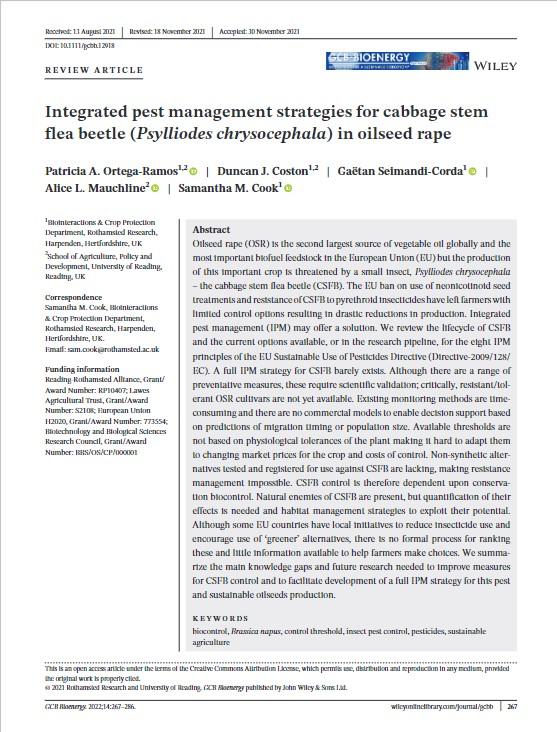Integrated pest management strategies for cabbage stem flea beetle (Psylliodes chrysocephala) in oilseed rape

Scientific paper in GCB Bioenergy 2021 by Patricia Ortega- Ramos, Duncan Coston, Gaëtan Seimandi-Corda, Alice Mauchline & Samantha Cook.
Abstract:
Oilseed rape (OSR) is the second largest source of vegetable oil globally and the most important biofuel feedstock in the European Union (EU) but the production of this important crop is threatened by a small insect, Psylliodes chrysocephala– the cabbage stem flea beetle (CSFB). The EU ban on use of neonicotinoid seed treatments and resistance of CSFB to pyrethroid insecticides have left farmers with limited control options resulting in drastic reductions in production. Integrated pest management (IPM) may offer a solution. We review the lifecycle of CSFB and the current options available, or in the research pipeline, for the eight IPM principles of the EU Sustainable Use of Pesticides Directive (Directive- 2009/128/EC). A full IPM strategy for CSFB barely exists. Although there are a range of preventative measures, these require scientific validation; critically, resistant/tol-erant OSR cultivars are not yet available. Existing monitoring methods are time- consuming and there are no commercial models to enable decision support based on predictions of migration timing or population size. Available thresholds are not based on physiological tolerances of the plant making it hard to adapt them to changing market prices for the crop and costs of control. Non- synthetic alter-natives tested and registered for use against CSFB are lacking, making resistance management impossible. CSFB control is therefore dependent upon conserva-tion biocontrol. Natural enemies of CSFB are present, but quantification of their effects is needed and habitat management strategies to exploit their potential. Although some EU countries have local initiatives to reduce insecticide use and encourage use of ‘greener’ alternatives, there is no formal process for ranking these and little information available to help farmers make choices. We summa-rize the main knowledge gaps and future research needed to improve measures for CSFB control and to facilitate development of a full IPM strategy for this pest and sustainable oilseeds production

